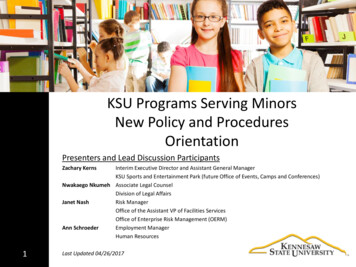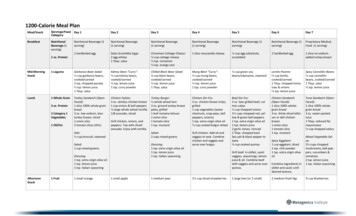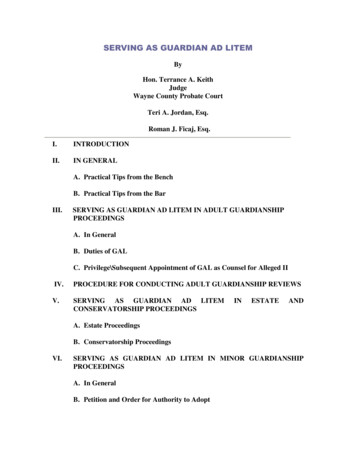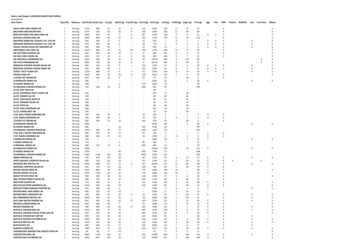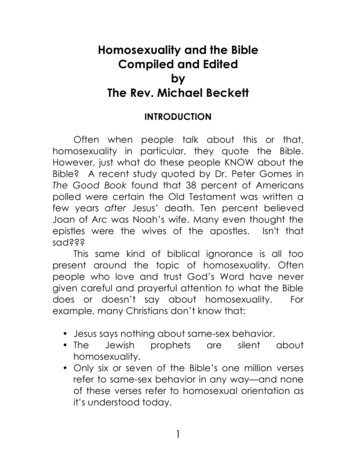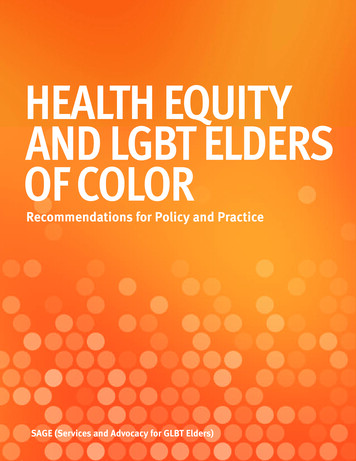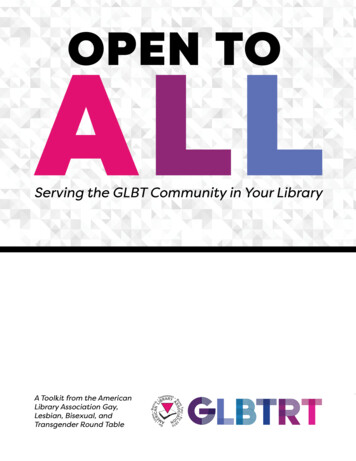
Transcription
OPEN TOALLServing the GLBT Community in Your LibraryA Toolkit from the AmericanLibrary Association Gay,Lesbian, Bisexual, andTransgender Round Table
Introduction Public libraries are committed to serving andrepresenting their entire community includingGLBT library users whether or not they are “out.” School libraries are particularly important;teenagers question their sexuality and identityand need a welcoming place; children andteens need to see themselves represented inbooks at school as well as at the public library. Academic libraries should not only provideaccess to collections and academic support,but also welcoming spaces.This Toolkit is designed to help library staffbetter understand gay, lesbian, bisexual andtransgender (GLBT) library users, how to bestserve their needs, and how to manage challengesthat often arise.Acceptance of GLBT people in mainstreamAmerican society has been steadily growing.However, library materials, programs, anddisplays related to sexual orientation andgender identity still cause controversy. The fearof a challenge may cause some librarians tobe deterred from buying materials or includingservices for GLBT people in their service profile;failing to provide these resources in ways thatcan be easily used by vulnerable populations areforms of censorship and discrimination.In any community, there are GLBT persons whoare not ready to be recognized as such, andit’s important to avoid assumptions and actwith respect. People who are “in the closet” orquestioning often need information resourcesthe most, so it is essential to provide safe andanonymous access, without judgment. It is vitalto create a welcoming environment for GLBTlibrary users in their communities, campuses, andschools.Every community has a GLBT population andGLBT families. The job of librarians, whetherserving adults, teens, children, students, parents,or others, is to make libraries welcoming andopen to all.Meeting the Needs of GLBT Library UsersGLBT library users don’t expect to be treated anydifferently than any other user; they want to be ableto find information that is relevant to them and theirneeds and to be treated with dignity and respect.matters; resources available in local brancheswithout the need to order them from thefar-flung reaches of the library galaxy; andprogramming to meet the needs of children,teens, adults, and families. Further, LGBTpatrons want all of these things withouthaving to ask.Symons and Freeman (2015) state that:LGBT patrons and their allies want theirprivacy protected from prying eyes (whichlibraries already do well); the ability tocheck out materials without comment orjudgment; materials that are interesting,timely, and bought on-par with other subjectGLBT community members may not be aware ofthe materials available to them at your library,so specialized promotion and outreach will raiseawareness and highlight the diversity of library2
resources. It is vital to hold programs and events forGLBT users and families.however, information about GLBT issues should be apart of every academic library collection.Collections that serve children should include fictionwith diverse protagonists of minority sexualities,gender identities, and family structures, as well asnonfiction materials for school research projects.Children are often aware of their sexuality and genderat an early age, and there are increasing numbers offamilies with same-gender parents. Representationof these identities and families is critical for buildinghealthy perceptions among youth.Health information is critical in all types of librariesas mainstream information often does not account forparticular risks or health complications faced by genderand sexual minorities. Additionally, such cases maybe difficult to access, due to either supply or insurancegaps, and individuals may rely on freely accessibleinformation until treatment is available.Library users are of all ethnic and racial backgrounds,nationalities, socio-economic classes, and abilities.Look for materials that include and celebrate diverseexperiences within GLBT communities and promoteaccessible and inclusive programming.Not all academic institutions include specific Genderand Sexuality Studies among their constituents,Pertinent TerminologyThe GLBT community is complex and has its ownterminology which can be very unfamiliar to some.The following two websites may be helpful in providingan understanding of terms and concepts used by yourGLBT library users. GLAAD Media Reference Guide: http://www.glaad.org/reference/lgb Human Rights Campaign Glossary of Terms: tical Tips for Library Services Avoid asking for gender on forms or dividingactivities by gender. If your facility marks single-seat bathrooms withgendered indicators, use neutral or inclusive symbolsto indicate the bathroom location. Many library users prefer self-checkout machinesand self-service holds because of privacy issues. Ifthis is not an option at your library, be sure your staffrespects all library users’ right to privacy. Create pathfinders, subject guides or reader’s advisorybookmarks related to topics of GLBT interest. Include GLBT books in genre or other displays and inbook talking and readers’ advisory. Keep conscious efforts within hiring practices tointerview and welcome the inclusion of GLBT staff. Think about “what you call people” who come intothe library. Do you tend to use gendered titles, such asSir or Ma’am? Addressing library users by a first namemay seem uncomfortable at first, but it could dowonders in making a trans library user feel welcome. Look at policies respecting library users’ choice tochange the name on their record. Changing names onfederal and state-issued ID cards can be an extensiveprocess; make policies that offer library users greatercontrol over their identity at the library. When talking to children, ask if an adult is with them.Not every child (not just those of same sex parents)has a mother and father. Doing this allows childrento respond how they are comfortable and lets parentsknow you are sensitive to a variety of families.3
Outreach and PartnershipsProgrammingCollaboration is key! Every community is different.You may have social service organizations or fraternalgroups in your area to connect with.Providing GLBT-friendly programming helps yourcommunity know that you are welcoming andaccepting. Create programs or displays to promote thefollowing events: In a larger city or urban area, check for a GLBTChamber of Commerce. In a more rural community,GLBT-related organizations may be few and distant. In schools, there are counselors, supportiveinstructors, and possibly gay-straight alliance groupsas well as Q Centers directly on campus or in thecommunity. Set up a meeting with your local GLBT communitygroups to discuss implementing programs, forexample, a specialized program, a film screening,a book discussion, etc. GLBT populations are oftenmisrepresented, so it is important to research and askquestions. Discuss your goals and ideas, and be open tocritiques and suggestions from community members.International Transgender Day of Visibility (March 31)National Day of Silence (April, day varies by year)Harvey Milk Day (May 22)GLBT Book Month (June): http://www.ala.org/GLBTBookMonthLGBT History Month (October)National Coming Out Day (October 11)Transgender Day of Remembrance (November 20)World AIDS Day (December 1)ADDITIONAL SUGGESTIONS AND TIPS FORPROGRAMMING INCLUDE: Hosting GLBT authors and speakers from GLBTorganizations. This signals that the library isinterested in serving GLBT people. Screening a GLBT-friendly movie (pursuant tolicensing rights). Implementing the right pace for change; determinewhat is best for your community and the paceat which you include programming - considerconsulting the Martin & Murdock (2007) publicationlisted below for specific information. At public libraries, holding inclusive story times andchildren’s activities utilizing GLBT-friendly picturebooks.ACADEMIC LIBRARIESOutreach on campus includes everyone fromprospective and current students to staff and faculty.Create partnerships with the campus GLBT resourcecenter and relevant departments to build a collectionand help facilitate an environment that fosters reading,inquiry, and critical thinking.PUBLIC LIBRARIESMany large cities have a GLBT center for teens andadults. In smaller and rural areas, it may be valuableto reach out to libraries in nearby cities for support.Partner with GLBT friendly businesses to promotelocal resources. Additionally, many communities havePFLAG chapters.Recommended ReadingGLBT Programming at the Dallas Public Library:Lessons Learned by Catherine Ritchie, DavidFettke and Dale McNeill. Public Libraries,March/April 2008, 50-54.SCHOOL LIBRARIESConsult with a local PFLAG group and consider doinga presentation to your parent teacher association onmaterials related to the GLBT community. Ensure thatschool staff, especially nurses and counselors, areaware that the library holds materials to support GLBTstudents. Partner with local Gay Straight Alliancegroups to offer book talking for younger students.Library Service to Special Population Childrenand Their Caregivers: A Toolkit for Librariansand Library Workers: ontent/professionaltools/lsspcc-toolkit-2015.pdf4
book awards such as Lambda Literary and PublishingTriangle. The size of the library isn’t necessarilya factor in collecting GLBT materials. One studyconducted by Loverich and Degnan (1999) found thatmany smaller libraries held more Stonewall BookAward winning titles than larger libraries.Serving Lesbian, Gay, Bisexual, Transgender andQuestioning Teens: A How-To-Do-It Manual forLibrarians by Hillians J. Martin, Jr., and JamesR. Murdock. Neal-Schuman publishers, Inc.,2007.Collection and CollectionDevelopmentGLBT Book Awards and BookListsThe collection is the heart of the library and shouldrepresent the diversity in the entire community andshould include materials for queer and questioninglibrary users. Stonewall Book Awards: http://www.ala.org/glbtrt/award Rainbow Book List: http://glbtrt.ala.org/rainbowbooks/ Over the Rainbow Book List: http://www.glbtrt.ala.org/overtherainbow/ Consider the following ALA (2010) policy whichstates that “The American Library Associationstringently and unequivocally maintains that librariesand librarians have an obligation to resist efforts thatsystematically exclude materials dealing with anysubject matter, including sex, gender identity, genderexpression, or sexual orientation.” Every library should have a collection developmentpolicy covering their collection. Sample collectiondevelopment policies are available online at theGLBTRT website: ion. Another useful tool forcreating or amending collection development policiescan be found in the Intellectual Freedom Manual, TrinaMagi, editor, 2015. A good library collection will include fiction andnon-fiction, informative and entertaining materials,graphic novels, audio books, videos, etc., for GLBTlibrary users of all ages. If your library has e-books/eaudio books in its collection, include a core collectionof GLBT materials. Annual bibliographies of GLBT materials are availablefrom the Gay, Lesbian, Bisexual, and TransgenderRound Table of the American Library Association(GLBTRT). The Rainbow Book List for GLBT books(for youth 0-18) and the Over the Rainbow Books (foradults) highlight some of the year’s best fiction andnonfiction. The Stonewall Book Awards, the oldestaward for GLBT literature, also recognizes adult,young adult, and children’s fiction and nonfiction.There are also other GLBT organizations which giveTen Titles for a Basic NonFiction GLBT CollectionMany Librarians are not sure where to start when itcomes to collecting materials for the GLBT community.Visit http://www.ala.org/glbtrt/nonfictioncollectionfor the list of Ten Titles for a Basic Non-Fiction GLBTCollection. It is not an exhaustive list, as there are manyquality titles that could be included, but serves as astarting point. This list will be updated as new titlesare published and will try to remain balanced in itsapproach of topics for GLBT customers. As you collectmaterials remember that having only a few books on atopic is better than not having none at all. You can alsoadd a variety of popular titles from the most currentStonewall Book Award, Rainbow Book list and Over theRainbow Book list.GLBT CollectionDevelopment ResourcesFOR CHILDREN AND YOUTH Rainbow Family Collections: Selecting and UsingChildren’s Books with Lesbian, Gay, Bisexual,Transgender, and Queer Content by Jaime CampbellNaidoo. Libraries Unlimited, 2012.5
vital; language is continually evolving, and catalogersshould remain current with terminology.FOR TEENS AND YOUNG ADULTS Top 250 LGBTQ Books for Teens: Coming Out, Being Out,and the Search for Community by Michael Cart andChristine A. Jenkins. Huron Street Press, 2015. The Heart Has Its Reasons: Young Adult Literature withGay/Lesbian/Queer Content 1969-2004 by Michael Cart& Christine Jenkins. Scarecrow Press, 2006.Libraries have made recent efforts to reclassify callnumbers to place GLBT materials among appropriatesections related to health, family, and relationships,rather than under “abnormal or deviant sexualbehavior.” GLBT materials should be classified in theirproper places. To avoid controversy, some librarieschoose their own classification numbers to avoidshelving children’s and fiction materials in nonfictionsections. Include materials in areas designated for thegenre and audiences of the same age.FOR ADULTS Gay, Lesbian, Bisexual, and Transgendered Literature: aGenre Guide by Ellen Bosman, John Bradford, RobertRidinger. Libraries Unlimited, 2008.CatalogingLabelingLibrary users utilize terms they are comfortableapplying to themselves when searching the catalog.Subject headings and call numbers have not alwaysbeen GLBT-friendly, however, librarians have advocatedfor improved terminology over time. “Intersex people”and “Transgender people” were added as Libraryof Congress subject headings in 2007. Periodicallyreviewing the catalog for offensive subject headings isThe ALA’s Labeling and Rating Systems: An Interpretationof the Library Bill of Rights (2005) cautions againstlabeling. Identifying books with a GLBT label mayprevent library users from accessing them for fearof being outed. Interfiling GLBT materials can be apositive move for libraries; when these materials areplaced alongside other books and materials, GLBT usersfeel welcomed and not ostracized.Collection ChallengesObjections or challenges to library materials occur, andchallenges to GLBT materials are common. Before achallenge occurs, ensure that your staff understandschallenge procedures. Each library should have acollection development policy as well as a policy forhandling challenges to materials.them. Challenges are not about libraries being rightor wrong; instead, it is an opportunity for the libraryto educate the public about the vital role we play inmeeting the information needs of diverse communities.The ALA Office of Intellectual Freedom should becontacted for help when materials are challenged.Additionally, many state library associations haveIntellectual Freedom Committees; contact members ofthese committees for valuable informational resources.Don’t preempt a challenge by avoiding purchasingGLBT materials. Library users have a right to materialsthat meet their needs, and libraries should provide6
GLBT Library StaffMany libraries have GLBT staff members. It may seemappropriate to ask their assistance with GLBT-relatedefforts or to assign them to GLBT outreach efforts.Before doing this, ask the staff member in confidence.Some members of the GLBT community prefer to keeptheir professional and personal lives separate, especiallyin smaller communities. In the workforce, GLBTemployees may not want to be treated as tokens or anydifferently from their colleagues. Libraries should adoptpolicies that prohibit discrimination and promote anatmosphere of inclusivity.Recommended ReadingOut Behind the Desk: Workplace Issues forLGBTQ Librarians, edited by Tracy Nectoux.Library Juice Press, 2011.ConclusionCourtney Young, 2014-2015 ALA President (2015) statesthat “We reaffirm that it is the responsibility of librarystaff everywhere, regardless of the legal ability to refuseservice, to offer equal and unfettered access to all usersin keeping with the Library Bill of Rights and principlesof intellectual freedom.” In keeping with that mission,libraries have the responsibility to provide informationand to serve all library users to the best of their ability.We invite you to join us in welcoming your GLBTlibrary users into the library through the provision ofmaterials, services, and programs that speak to them,meet their needs, and will help them realize their fullpotential. GLBT library users need the same servicesprovided to all library users: access to information andexcellent customer service. We hope this toolkit willhelp you serve them well.ReferencesAmerican Library Association. (2005). Labels andrating systems: An interpretation of the LibraryBill of Rights. Retrieved from /interpretations/labelingratingSymons, A. K. & Freeman, J. (2015, June), Servingeveryone: Welcoming the LGBT community.American Libraries, 30. Retrieved from rving-everyone/American Library Association. (2010). B.2.1.15Access to library resources and services regardlessof sex, gender identity, gender expression, orsexual orientation. Retrieved from g, C. (2015). ALA President Courtney Youngreleases statement regarding Indiana’s new ReligiousFreedom Restoration Act. Retrieved from ng-indiana-s-newLoverich, P., & Degnan, D. (1999). Out on the shelves?not really: Gay, lesbian, bisexual books in shortsupply. Library Journal, 124.11, 55.7
The GLBTRT thanks the Advocacy Committee members and others who contributed to this toolkit:Alex Andrasik, Mary Gen Davies, Peter Coyl, Tess Goldwasser, Samantha Helmick, Lisa Houde, Vanessa Kitzie,Stephanie Preston, Mark Polger, AJ Robinson, Deb Sica, Karla Strand, Ann Symons, and Julie Winkelstein.
graphic novels, audio books, videos, etc., for GLBT library users of all ages. If your library has e-books/e-audio books in its collection, include a core collection of GLBT materials. Annual bibliographies of GLBT materials are available from the Gay, Lesbian, Bisexual, and Transgender Round Table of the American Library Association (GLBTRT).




